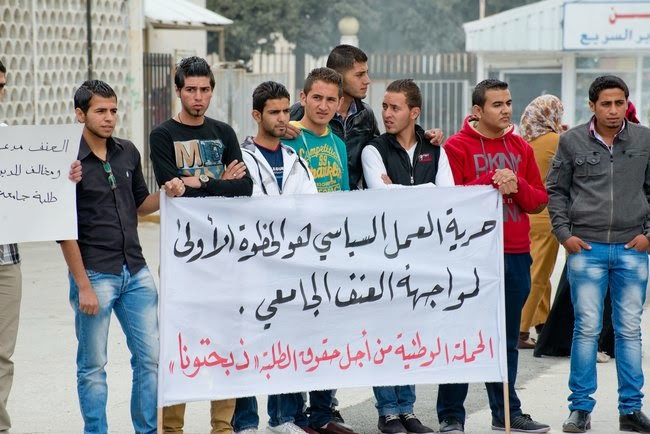صدامات عشائرية في الجامعات الأردنية ثمرة الفساد في المخابرات والديوان الملكي
IHT SPECIAL
Tribal Clashes at Universities Add to Tensions in Jordan
By RANA F.
SWEIS
Published:
April 24, 2013
AMMAN — They may begin with a slur, a passing glance or an accidental
shove: Student brawls that turn into tribal confrontations have become an
increasingly worrying phenomenon on university campuses across Jordan.
Already
tested by tensions between “East Bank” tribes and ‘West Bank”Palestinians, and contested by pro-democracy
activists, the country’s authorities now must respond to rising inter-tribal
hostilities among the young.
“Tribal
violence at universities is reaching an alarming level,” said Mohammad Nsour, a
lawyer and associate professor at the faculty of law at the University of
Jordan. “It has reached a level where we are reminded of the sectarian violence
in Lebanon and Iraq.”
With
264,000 students enrolled in public and private universities, according to the
ministry of higher education, the descent into tribalism threatens to undermine
both the rule of law and Jordan’s respected academic institutions.
Nearly
two years ago, academics and social experts drew up a comprehensive strategy to
combat campus violence. Their report found that failures of law enforcement had
enabled a hard core of troublemakers to incite repeated disturbances with
impunity.
“You have
to enforce the law, even ruthlessly,” said Hasan Barari, professor of
international studies at the University of Jordan and a political analyst. “But
there is no will.”
“At the
university level, there are certain things that can be done that can mitigate
the phenomena, and no one is doing that,” he added.
Nearly 40
major fights have taken place this year at universities across the kingdom,
according to data reported this month by Thabhtoona, a national campaign for
students’ rights. That compares with 80 such outbreaks all of last year, 61 in
2011 and 29 in 2010.
Mr. Nsour
said admission policies have contributed to campus violence. Universities had
been obliged to accept exceptionally underprivileged students, refugees and
some unqualified students supported by the Royal Court, he said, seeding the
ground for future trouble.
These
students “cannot cope academically, but they still feel they can violate the
system because they were not accepted based on merit,” he said. “They become
frustrated and take it out on other students.”
There is
a deep concern that tribal tensions in the universities will turn into a wider
societal problem.
Lacking
natural resources to build the economy, the government has consistently focused
on developing its human potential. The literacy rate among Jordanians aged 15
to 24 stands at more than 90 percent, according to the World Bank. Jordan’s
higher education system is highly regarded throughout the region.
Yet, with
nearly 70 percent of the population under age 30, and unemployment mainly affecting
the young, the country faces a major social and economic challenge. According
to the World Bank, 25.6 percent of 20-to-24-year-olds are unemployed, of whom
more than half hold a secondary certificate or a higher level of education.
Since the
start of 2012, there have been some 50 protests by unemployed youths, according
to Labor Watch, a local nongovernmental organization.
“This is
the second consecutive year that we are suffering from violence across
university campuses,” said Mustafa Al Adwan, secretary general at the Ministry
of Higher Education and Scientific Research, “and it is not only in a certain
area or type of university, it is a nationwide problem.”
The death
of an engineering student, Osama Duheisat, 21, in a tribal brawl this month at
Mutah, a public university in the impoverished southern city of Karak, spilled
over into widespread protests outside the campus.
“Sometimes
we think it’s a social phenomena and not only related to universities,” Mr.
Adwan said. “After a brawl between two students the problem extends to the
areas surrounding the university.”
Hundreds
of students across several universities held rallies last week to protest
violence on their campuses, holding large photos of Mr. Duheisat, who is
believed to have simply been a bystander at a brawl that ended in classes being
suspended for two days.
Mustafa,
20, a student who did not want his last name used because he feared
retribution, said he recently found himself in the middle of a fight at his
university.
“I was as
far away as possible from the fight that took place between two young men and
it suddenly grew, became tribal and many people became involved,” said Mustafa,
whom his professor described as an exemplary student.
“That
same day, I was sitting in class and then a young man entered our classroom
before the professor arrived,” he said. “A student pointed at me and said, ‘He
is originally from the north.”’
He said
the man dragged him outside the classroom, then assaulted him.
“I had
nothing to do with the brawl between the two students, but it was retribution
and revenge between tribes from the north and the south,” he said. “They found
someone from the north in the classroom, and that was me.”
No
measures had been taken against the person who assaulted him, who remained on
the campus, he added.
Mr. Adwan, the education
ministry official, said: “Our youth, who represent our future, are increasingly
finding it hard to accept the other. What will this mean for our society in the
future? We need to seriously resolve this issue. It is time to implement the
laws.”
A version of this article appeared in print on
April 25, 2013, in The International
Herald Tribune.










تعليقات